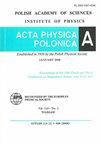Application of X-rays to Interpret Intensity Ratios for Nickel in Nickel (II) Oxide
IF 0.5
4区 物理与天体物理
Q4 PHYSICS, MULTIDISCIPLINARY
引用次数: 0
Abstract
The K -shell characteristic X-ray intensity ratios of nickel (II) oxide thin films generated by chemical spraying with 1–6 percent boron doping were studied. An americium-241 radioisotope source generated 59.543 kilo-electron volt gamma rays at 50 mili Curie intensity for these samples. The distinctive X-rays of the samples were calculated using a Canberra ultra-low energy germanium detector (with a resolution of 150 electron volts at 5.96 keV). The results were interpreted based on the amount of boron doped in nickel (II) oxide thin films, and it was discovered that, with the exception of boron doping quantities of 5 percent and 6 percent, K -shell X-ray intensity ratios rose as boron doping amounts increased. The findings are given and compared to those of the previous study. The obtained results are provided and compared in the table to the other researchers’ theoretical and experimental results应用x射线解释镍(II)氧化物中镍的强度比
研究了1 ~ 6%硼掺杂化学喷涂制备的氧化镍薄膜的K壳特征x射线强度比。在这些样品中,镅-241放射性同位素源产生了59.543千电子伏特的50毫居里强度的伽马射线。使用堪培拉超低能锗探测器(分辨率为150电子伏特,5.96 keV)计算样品的独特x射线。结果基于镍(II)氧化物薄膜中硼掺杂量的解释,发现除了硼掺杂量为5%和6%外,K -壳层x射线强度比随着硼掺杂量的增加而增加。给出了研究结果,并与之前的研究结果进行了比较。所获得的结果在表格中提供并与其他研究人员的理论和实验结果进行了比较
本文章由计算机程序翻译,如有差异,请以英文原文为准。
求助全文
约1分钟内获得全文
求助全文
来源期刊

Acta Physica Polonica A
物理-物理:综合
CiteScore
1.50
自引率
0.00%
发文量
141
审稿时长
6 months
期刊介绍:
Contributions which report original research results
and reviews in the fields of General Physics, Atomic and
Molecular Physics, Optics and Quantum Optics, Quantum Information, Biophysics, Condensed Matter, and
Applied Physics are welcomed.
 求助内容:
求助内容: 应助结果提醒方式:
应助结果提醒方式:


